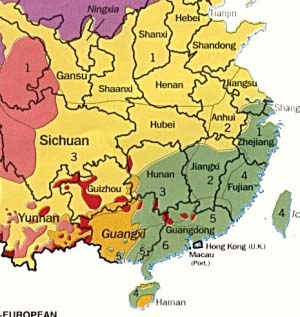|
Thursday, January 24, 2008
Via Dienekes, a new paper, A spatial analysis of genetic structure of human populations in China reveals distinct difference between maternal and paternal lineages:
Analyses of archeological, anatomical, linguistic, and genetic data suggested consistently the presence of a significant boundary between the populations of north and south in China. However, the exact location and the strength of this boundary have remained controversial. In this study, we systematically explored the spatial genetic structure and the boundary of north-south division of human populations using mtDNA data in 91 populations and Y-chromosome data in 143 populations. Our results highlight a distinct difference between spatial genetic structures of maternal and paternal lineages. A substantial genetic differentiation between northern and southern populations is the characteristic of maternal structure, with a significant uninterrupted genetic boundary extending approximately along the Huai River and Qin Mountains north to Yangtze River. On the paternal side, however, no obvious genetic differentiation between northern and southern populations is revealed.  The simplest model here is that north Chinese Han males spread over the country and intermarried with southern females. That explains the distinction between northern and southern lineages. But, I think it is important to be specific about the anthropological details which manifested on the local level. The Han are traditionally a patrlineal and patrilocal people. My understanding is that patrilineality and the "clan system" is more extreme in the south than the north. Additionally, going back to the Warring States period before the rise of the Imperial Chinese system scholar-officials would move from state to state in search of employment, power and prestige. On a larger scale there is the historical reality that several times in Chinese history Han ethnic dominance has retreated from the north China plain to a southern redoubt. The subsequent expulsion of barbarians from north China was then accompanied by the migration of long established southern lineages to northern power centers. So one might assume that these southern lineages were originally derived from the north, but after a while it might get difficult to sort out who was who (north & south). Of course the historical record might simply reflect the shifts in elites who remained in power on top of a relatively static ethnic situation in the north, while the south went through a general long term trend of sinicization which accelerated during periods of barbarian rule in the north when the gentry supplemented the local Han base. Finally, do note that south China is geographically far more fragmented than north China, and we know in other contexts this has a long term effect on mating patterns and dynamics. I am also interested why the Mandarin dialects managed to take over southwest China (see map) but not southeast China. The simplest model here is that north Chinese Han males spread over the country and intermarried with southern females. That explains the distinction between northern and southern lineages. But, I think it is important to be specific about the anthropological details which manifested on the local level. The Han are traditionally a patrlineal and patrilocal people. My understanding is that patrilineality and the "clan system" is more extreme in the south than the north. Additionally, going back to the Warring States period before the rise of the Imperial Chinese system scholar-officials would move from state to state in search of employment, power and prestige. On a larger scale there is the historical reality that several times in Chinese history Han ethnic dominance has retreated from the north China plain to a southern redoubt. The subsequent expulsion of barbarians from north China was then accompanied by the migration of long established southern lineages to northern power centers. So one might assume that these southern lineages were originally derived from the north, but after a while it might get difficult to sort out who was who (north & south). Of course the historical record might simply reflect the shifts in elites who remained in power on top of a relatively static ethnic situation in the north, while the south went through a general long term trend of sinicization which accelerated during periods of barbarian rule in the north when the gentry supplemented the local Han base. Finally, do note that south China is geographically far more fragmented than north China, and we know in other contexts this has a long term effect on mating patterns and dynamics. I am also interested why the Mandarin dialects managed to take over southwest China (see map) but not southeast China.Genetically this sex-based distinction seems to confirmed by repeated studies. But, that being said, remember that in the early 1990s Cavalli-Sfroza reported in The History and Geography of Human Genes that north Chinese were genetically closer to Japanese and Koreans and south Chinese with southeast Asians when looking at traditional autosomal loci. It is historically attested that groups like the Thai and Vietnamese have origins within what is now south China (the Thai still have ethnic relations within China proper). Ethographic analysis also suggests the Cantonese, for example, preserve customs which are clearly descended from local traditions which pre-date a Han identity for the people in the region. It would be nice to have a STRUCTURE based analysis address these questions..... Note: Most of the Overseas Chinese are from the south. Especially Fujian. The older Chinese communities in the United States tend to be Cantonese. |



